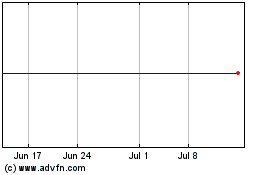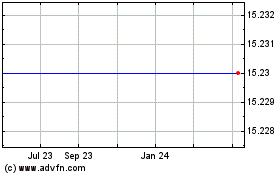Fiat Chrysler, PSA Group Merge to Create New Auto-Making Behemoth
January 16 2021 - 6:41AM
Dow Jones News
By Nora Naughton
Fiat Chrysler Automobiles NV and Peugeot-maker PSA Group
cemented their trans-Atlantic merger Saturday, creating Stellantis
NV, a global auto-making giant that executives say will have the
heft needed to compete in a fast-changing industry.
The deal, first agreed to in late 2019 and approved earlier this
month by shareholders, comes as the global car business is rapidly
shifting to new technologies, such as electric vehicles, and
battling upstarts trying to upend everything from the way cars are
engineered and built to how they are sold.
Stellantis, derived from Latin term meaning " to brighten with
stars," ranks as the world's third-largest auto maker by sales,
according to 2019 figures, the latest available. At Friday's close,
it was worth more than $51 billion. The newly formed car company
plans to start trading under the ticker symbol STLA on the Paris
and Milan stock exchanges Monday and in New York on Tuesday.
Stellantis will have a major presence in North America and more
than a quarter of the market in Europe, selling vehicles through a
massive collection of brands, ranging from American names like Jeep
and Ram to Peugeot, Citroën and Opel in Europe and Maserati and
Alfa Romeo on the luxury end.
In a turbulent year for many global manufacturers, executives at
FCA and PSA pushed forward with the merger, saying the challenges
posed by the Covid-19 pandemic have only reinforced the need for
the combination. They estimate the tie-up could eventually produce
$6 billion in annual cost savings, in part by consolidating the two
companies' engineering and parts purchasing to drive larger
economies of scale.
Still, the auto sector has a spotty record with megamergers and
many of Stellantis's rivals, including General Motors Co., are
moving in the opposite direction, retrenching from money-losing
regions and shrinking their global operations to be more
nimble.
Carlos Tavares, the PSA chief now leading Stellantis, faces
numerous challenges in fitting these two companies together,
including underperforming factories, lagging brands and an ailing
China business.
"The trickiest part of every merger is when you have to mix all
of the cultures," said Carla Bailo, president of the Center for
Automotive Research and a former co-worker of Mr. Tavares at Nissan
Motor Co.
The 62-year-old Mr. Tavares is known in automotive circles for
his success in turning around faltering businesses. When he first
arrived at Peugeot from Renault in 2013, the company was bleeding
cash. Within six years, he transformed it into one of the most
profitable European car companies with PSA posting an operating
margin of 8.5% in 2019. He later revived Opel and Vauxhall, two
once-struggling European brands that PSA purchased from GM in
2017.
At PSA, the turnaround was largely achieved by pulling back on
profit-damaging sales discounts and pushing the company to be
hypervigilant about costs. He also trimmed the workforce without
closing plants, negotiating new union agreements and eliminating
jobs through buyouts.
It is a formula, some analysts say, he is likely to apply at
Stellantis, which employs about 400,000 workers globally.
One of Mr. Tavares's largest undertakings will be melding the
two auto makers' manufacturing operations, which together comprise
nearly 50 factories globally -- many of them operating at well
below capacity, according to data provided by research firm LMC
Automotive. He also needs to reinvigorate the business in China,
where the two companies' combined sales now account for less than
1% of a market that sold 20 million vehicles last year, and fix
Fiat Chrysler's money-losing operations in Europe.
On electric vehicles, Stellantis will be under pressure to match
the investment being poured into the technology by competitors,
like GM, which plans to spend $27 billion through 2025 on electric
and self-driving cars.
While Fiat Chrysler and PSA have worked to expand plug-in
offerings and secure battery supplies, the marketplace is becoming
increasingly competitive with both traditional car companies and
well-funded startups getting ready to release a wave of new
electric models this year.
Stellantis plans to divert the bulk of the $6 billion in
projected yearly savings to developing electric vehicles and other
costly technologies. But first it must tackle areas of overlap in
manufacturing and vehicle lineups, without closing plants and
eliminating brands as executives have promised, a task that
industry analysts say could be tricky as car companies continue to
confront depressed sales during the pandemic.
Ms. Bailo says Mr. Tavares, a Portugese-born auto fanatic who
spends many weekends racing cars, is likely to take time to assess
the business and get to know his counterparts at Fiat Chrysler
before making any major changes.
"He's not the kind of leader who gives you a target and says,
'Go find a way to meet it,'" she said. "He's much more hands-on
than the typical leader."
Write to Nora Naughton at Nora.Naughton@wsj.com
(END) Dow Jones Newswires
January 16, 2021 06:26 ET (11:26 GMT)
Copyright (c) 2021 Dow Jones & Company, Inc.
Fiat Chrysler Automobile... (NYSE:FCAU)
Historical Stock Chart
From Mar 2024 to Apr 2024

Fiat Chrysler Automobile... (NYSE:FCAU)
Historical Stock Chart
From Apr 2023 to Apr 2024
